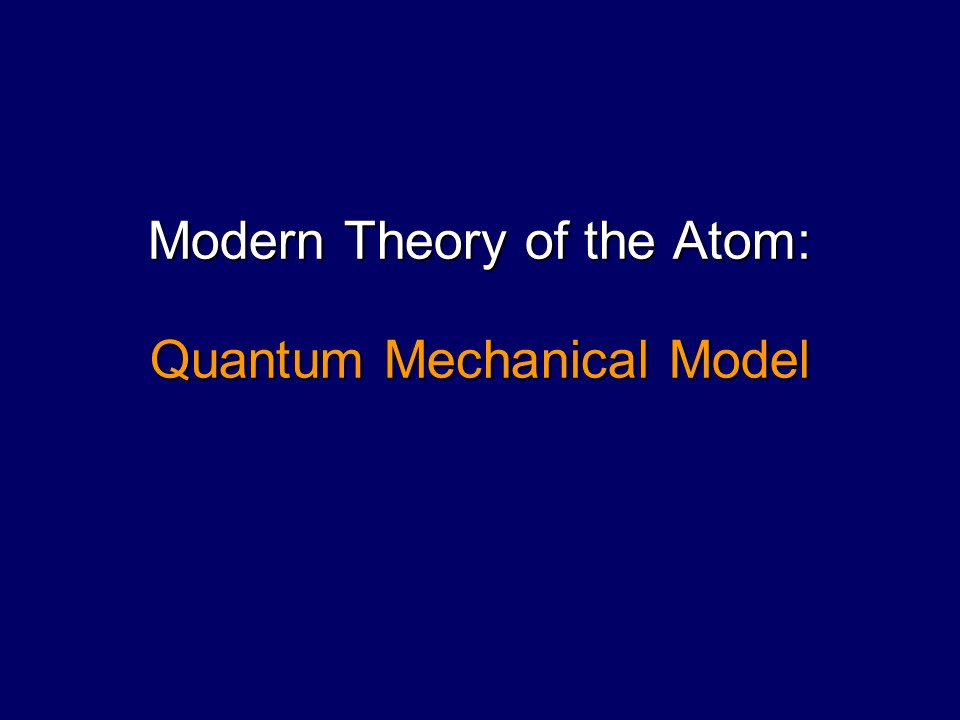Modern Theory of the Atom: Quantum Mechanical Model - PowerPoint PPT Presentation
Title:
Modern Theory of the Atom: Quantum Mechanical Model
Description:
Modern Theory of the Atom: Quantum Mechanical Model Frequencies in Chemistry Electron Configuration & PT Principle Energy Levels Sublevels Orbitals hold 2 electrons ... – PowerPoint PPT presentation
Number of Views:287
Avg rating:3.0/5.0
Title: Modern Theory of the Atom: Quantum Mechanical Model
1
Modern Theory of the AtomQuantum Mechanical
Model
2
(No Transcript)
3
Recap of Bohr Model
- electrons
- particles moving in circular orbits with specific
speed, position, energy - quantization of energy levels is imposed
- electrons can move between energy levels
- higher energy levels farther from nucleus
- moving up to higher E level electron absorbs
energy - moving down to lower E level electron emits
light energy - Ground state
- electrons located in lowest possible energy
levels - closest can be to nucleus
4
(No Transcript)
5
1924 De Broglie
- Proposed this Idea
- if light can show both particle and wave
behavior, maybe matter can too
6
(No Transcript)
7
(No Transcript)
8
(No Transcript)
9
2 kinds of waves
- Traveling wave
- wave not confined to given space
- travels from one location to another
- interrupted by hitting
- boundary or another
- wave
- Standing wave
- confined to given space (ends are pinned)
- interference between incident reflected waves
- at certain frequencies
- certain points seem to be standing still
- other points - displacement changes in regular way
10
- Traveling Wave
11
- Standing wave
12
DeBroglie Electron-Wave
wavelength describing electron depends on energy
of electron at certain energies, electron waves
make standing waves in atom wave does not
represent path of electron
13
Modern Theory
- electron treated as wave
- cannot specify both position speed of electron
- can determine probability of electrons location
in given region of space - Quantized energy levels arise naturally out of
wave treatment
14
Bohr Model vs. Modern Theory
- electron particle
- e- path is orbit
- holds 2n2 electrons
- circular path
- each orbit has specific energy
- can find exact position/ speed
- electron wave
- e path is orbital
- holds 2 electrons
- not necessarily circular
- each orbit has specific energy
- probable location
15
Heisenberg uncertainty principle
- Fundamentally impossible to know velocity
position of particle at same time - Impossible to make observation without
influencing system
16
What can orbitals do for us?
- Physical structure of orbitals explain
- Bonding
- Magnetism
- Size of atoms
- Structure of crystals
17
Orbital Modern Theory
- orbital term describes region where e- might be
found - each orbital
- specific energy specific shape
- described by 4 parameters of wave function (like
an address) - quantum numbers n, l, m, s
18
n principal quantum number
- specifies atoms principal energy levels
- whole number values 1, 2, 3, 4,
- maximum electrons in any principal energy level
2n2
19
l Describes sublevels
- principal energy levels have sublevels
- sublevels depends on principal energy level
- 1st principal energy level has 1 sublevel
- 2nd
2 - 3rd 3
- 4Th 4
, etc.
20
Naming sublevels
- Sublevels are labeled by shapes
- s, p, d, f
- s orbitals spherical
- p orbitals dumbbell shaped
- d f orbitals more complex shapes
21
m 3rd quantum number
- sublevels made up of orbitals
- each sublevel has specific of orbitals
sublevel of orbitals
s 1
p 3
d 5
f 7
22
s orbital shapes
23
p orbital shapes
24
d orbital shapes
25
f orbital shapes
26
4th quantum number s
- e- spin 2 possible values
- clockwise and counter clockwise
27
Address for each electron
- 4 quantum numbers
- no 2 e- can
- occupy the same space in atom
- can have same 4 quantum numbers
- therefore only 2 electrons per orbital
- (Pauli exclusion principle)
28
principle energy level sublevels orbitals total e-
1 s 1 2
2 s 1 2
p 3 6
3 s 1 2
p 3 6
d 5 10
4 s 1 2
p 3 6
d 5 10
f 7 14
29
3rd principal energy level, 3 sublevels
2nd principal energy level, 2 sublevels s p
1st principal energy level, 1 sublevel s
Each box represents an orbital and holds 2
electrons
30
Order of fill Aufbau Principle
- each electron occupies lowest energy orbital
available - learn sequence of orbitals from lowest to highest
energy - some overlap between sublevels of different
principal energy levels
31
Aufbau Principle
- Follow arrows
- sequence of orbitals
- 1s, 2s, 2p, 3s, 3p, 4s,
- 3d, 4p, 5s, 4d,
- exceptions do occur
- half-filled orbitals
- have extra stability
- - magic is 8
- 1s
- 2s 2p
- 3s 3p 3d
- 4s 4p 4d 4f
- 5s 5p 5d 5f
- 6s 6p 6d 6f
- 7s 7p
32
Electron Configurations
33
Compare Bohr Schrodinger
34
Frequencies in Chemistry
35
Electron Configuration PT
36
(No Transcript)
37
?































